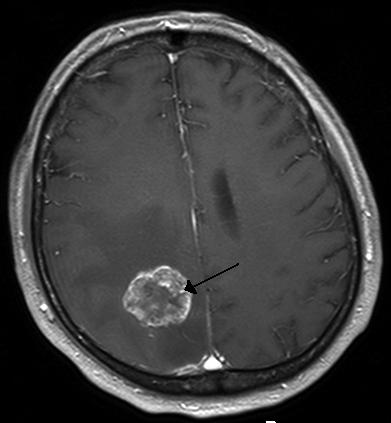Brain tumor
| Brain tumor | |
 | |
|---|---|
| CT scan of brain showing brain cancer to left parietal lobe in the peri-ventricular area.https://en.wikipedia.org/wiki/File:Hirnmetastase_MRT-T1_KM.jpg |
|
Brain tumor Microchapters |
For patient information click here
Editor-In-Chief: C. Michael Gibson, M.S., M.D. [1] Assosciate editor(s)-In-Chief Fahimeh Shojaei, M.D., Prashanth Saddala, Sujit Routray, M.D. [2]
Synonyms and keywords: Brain tumour; brain cancer; intracranial tumor; astrocytoma; glioblastoma; oligodendrocytoma; meningioma; ependymoma; craniopharyngioma.
Overview
Classification
Brain tumors can be classified as follows:
| Brain tumors | |||||||||||||||||||||||||||||||||||||||||||||||||||
| Adult primary brain tumor | Childhood primary brain tumor | Brain metastase | |||||||||||||||||||||||||||||||||||||||||||||||||
•Glioblastoma multiforme •Oligodendroglioma •Meningioma •Hemangioblastoma •Pituitary adenoma •Schwannoma •Primary CNS lymphoma | •Pilocytic astrocytoma •Medulloblastoma •Ependymoma •Craniopharyngioma •Pinealoma | •Lung cancer •Breast cancer •Melanoma •Gastrointestinal tract cancer •Renal cell carcinoma •Osteosarcoma •Head and neck cancer •Neuroblastoma •Lymphoma •Prostate cancer | |||||||||||||||||||||||||||||||||||||||||||||||||
Causes
The exact cause of brain tumor is not known.
Differentiating Brain Tumor from other Diseases
On the basis of seizure, visual disturbance, and constitutional symptoms, brain tumors must be differentiated from AV malformation, brain aneurysm, bacterial brain abscess, tuberculosis, toxoplasmosis, hydatid cyst, CNS cryptococcosis, CNS aspergillosis, and brain metastasis.
| Diseases | Clinical manifestations | Para-clinical findings | Gold standard |
Additional findings | ||||||
|---|---|---|---|---|---|---|---|---|---|---|
| Symptoms | Physical examination | |||||||||
| Lab Findings | MRI | Immunohistopathology | ||||||||
| Head- ache |
Seizure | Visual disturbance | Constitutional | Focal neurological deficit | ||||||
| Adult primary brain tumors | ||||||||||
| Glioblastoma multiforme |
+ | +/− | +/− | − | + | − |
|
|
| |
| Oligodendroglioma |
+ | + | +/− | − | + | − |
|
|
| |
| Meningioma |
+ | +/− | +/− | − | + | − |
|
|
| |
| Hemangioblastoma |
+ | +/− | +/− | − | + | − |
|
| ||
| Pituitary adenoma [1] |
− | − | + Bitemporal hemianopia | − | − |
|
|
|
| |
| Schwannoma |
− | − | − | − | + | − |
|
|
| |
| Primary CNS lymphoma |
+ | +/− | +/− | − | + | − |
|
|
| |
| Childhood primary brain tumors | ||||||||||
| Pilocytic astrocytoma |
+ | +/− | +/− | − | + | − |
|
|
| |
| Medulloblastoma |
+ | +/− | +/− | − | + | − |
|
|
| |
| Ependymoma [1] |
+ | +/− | +/− | − | + | − |
|
|
| |
| Craniopharyngioma [1] |
+ | +/− | + Bitemporal hemianopia | − | + |
|
|
|
| |
| Pinealoma |
+ | +/− | +/− | − | + vertical gaze palsy |
|
|
|
| |
| Vascular | ||||||||||
| AV malformation [1] |
+ | + | +/− | − | +/− | − |
|
| ||
| Brain aneurysm |
+ | +/− | +/− | − | +/− | − |
|
|
|
|
| Infectious | ||||||||||
| Bacterial brain abscess |
+ | +/− | +/− | + | + |
|
|
|
|
|
| Tuberculosis [1] |
+ | +/− | +/− | + | + |
|
|
|
|
|
| Toxoplasmosis |
+ | +/− | +/− | − | + |
|
|
|
|
|
| Hydatid cyst [1] |
+ | +/− | +/− | +/− | + |
|
|
|
|
|
| CNS cryptococcosis |
+ | +/− | +/− | + | + |
|
|
|
|
|
| CNS aspergillosis |
+ | +/− | +/− | + | + |
|
|
|
|
|
| Other | ||||||||||
| Brain metastasis [1] |
+ | +/− | +/− | + | + | − |
|
|
|
|
ABBREVIATIONS
CNS=Central nervous system, AV=Arteriovenous, CSF=Cerebrospinal fluid, NF-2=Neurofibromatosis type 2, MEN-1=Multiple endocrine neoplasia, GFAP=Glial fibrillary acidic protein, HIV=Human immunodeficiency virus, BhCG=Human chorionic gonadotropin, ESR=Erythrocyte sedimentation rate, AFB=Acid fast bacilli, MRA=Magnetic resonance angiography, CTA=CT angiography